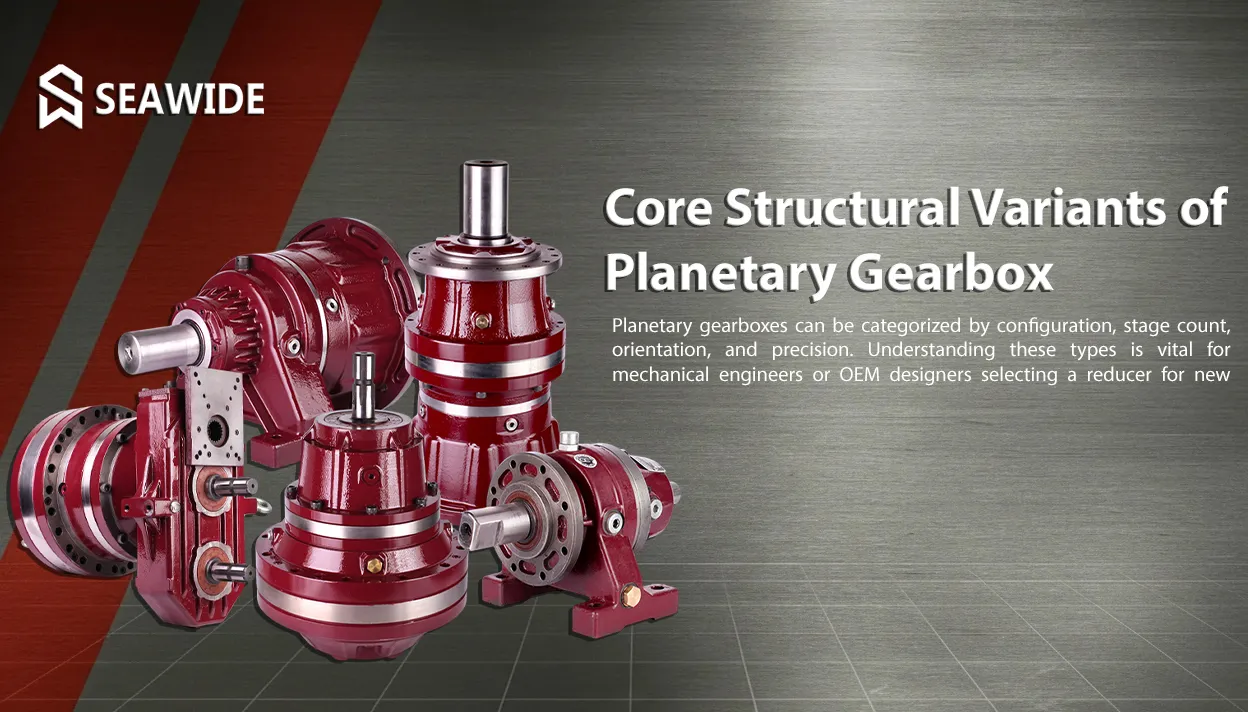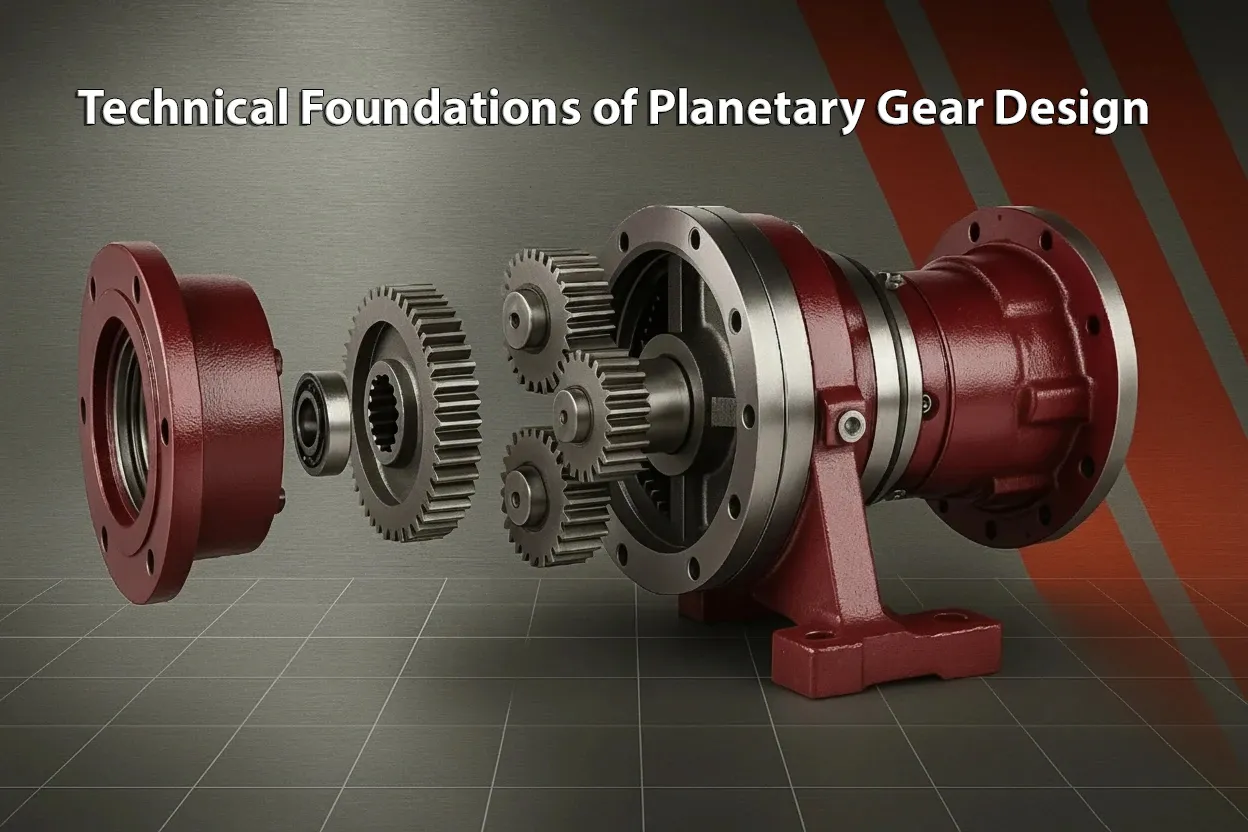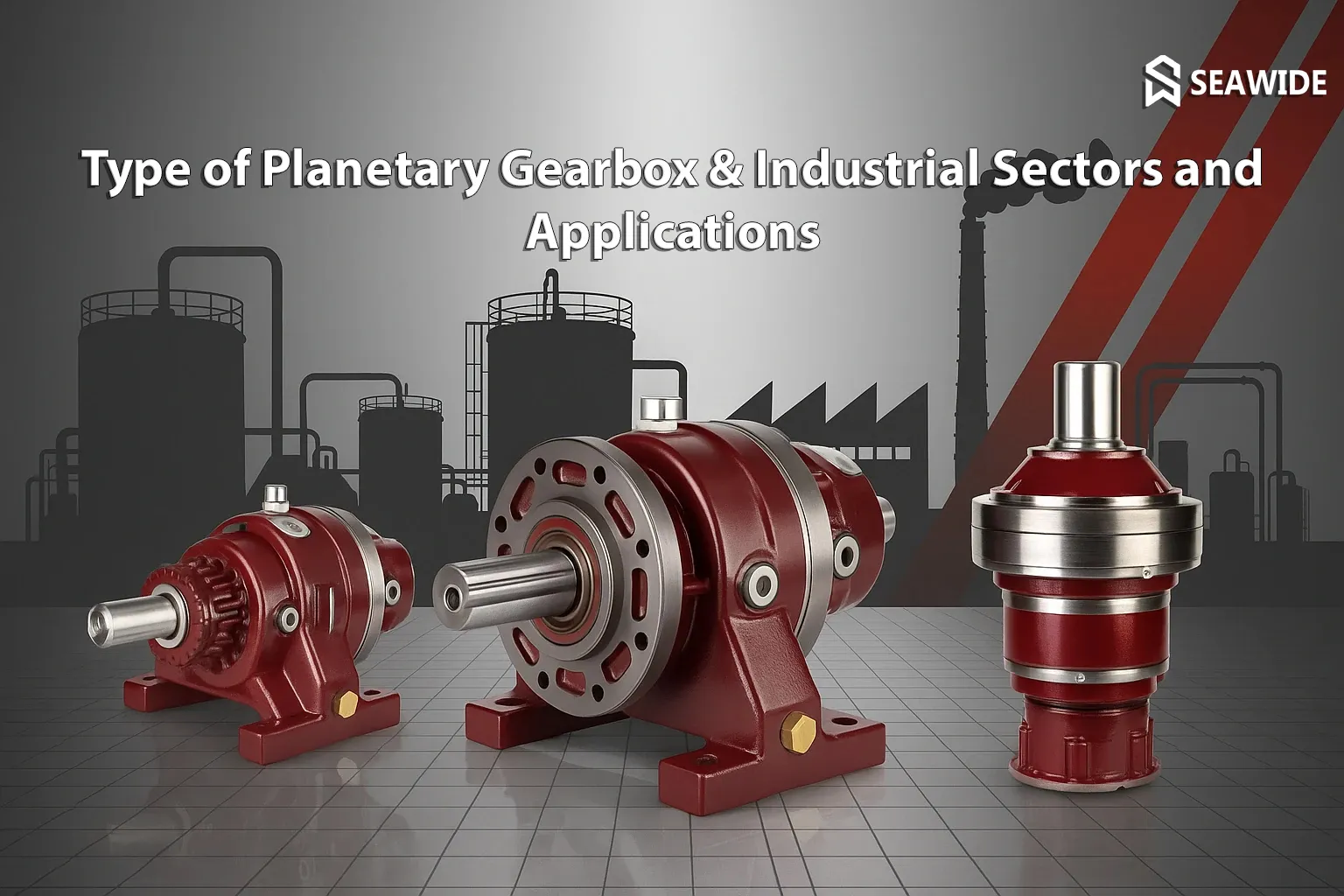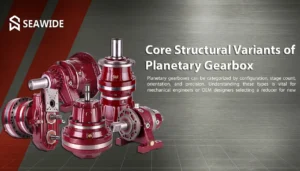Types of Planetary Gearbox: Structure, Design & Industrial Applications
Introduction: The Backbone of Modern Mechanical Power Transmission
In the world of industrial power transmission, gearboxes stand as the core mechanical elements translating rotary energy into controlled motion. From conveyor lines and marine winches to wind turbines and cement kilns, no powertrain operates efficiently without precise torque control. Among the various gearbox designs—helical, bevel, worm, and spur—the planetary gearbox has earned a distinct place for its compact construction, incomparable torque density, and superior efficiency.
Also known as an epicyclic gear reducer, the planetary gearbox features multiple intermeshing gears that share the transmitted load equally, ensuring energy efficiency often exceeding 95%. This multi‑mesh advantage allows smaller housings to deliver torque levels equivalent to much larger helical reducers. That synergy of size and strength has made planetary systems the first choice in demanding sectors such as mining, metallurgy, oil & gas, and renewable energy engineering.

What Is a Planetary Gearbox?
Watch the video to see how a planetary gearbox works.
A standard planetary gearbox contains four key components:
- Sun Gear: the central gear that receives input power from the motor or prime mover.
- Planet Gears: multiple spur gears revolving around the sun; these distribute and share the transmitted torque.
- Ring Gear: a fixed outer gear with internal teeth.
- Carrier: the frame that holds the planet gears and delivers the output motion.
The mechanical interaction between the sun, planets, and ring creates several simultaneous contact points, resulting in up to three times higher load‑bearing capacity compared to conventional parallel‑shaft gear systems.
By adjusting either the number of planetary stages or their gear dimensions, engineers can achieve reduction ratios ranging from about 3:1 to more than 2500:1, while keeping excellent precision, minimal backlash, and strong concentric alignment.
When the ring gear is fixed and the sun gear provides the input, the planet carrier becomes the output member.
In this configuration, the carrier rotates more slowly than the sun gear, producing speed reduction and torque multiplication.
The degree of reduction depends on how large the ring gear is compared with the sun gear. A larger ring gear leads to a slower output speed and greater torque amplification.
This speed relationship—originally described in Willis’s kinematic principle—illustrates the fundamental operation of planetary gearboxes used in modern industrial and automation applications.
Planetary Gearbox Supplier | Gearbox for Sale & price-SEAWIDE
Types of Planetary Gearbox & Core Structural Variants of Planetary Gearboxes
Planetary gearboxes can be categorized by configuration, stage count, orientation, and precision. Understanding these types is vital for mechanical engineers or OEM designers selecting a reducer for new installations or retrofits.
1. Single‑Stage Planetary Gearbox
Structure: One sun–planet–ring assembly, producing a typical reduction ratio between 3:1 and 10:1. The planets are mounted on a carrier that serves as the output.
Design Considerations:
The maximum load capacity is limited by the face width and the number of planets (usually 3 or 4). Since there is only one mesh point per planet, heat dissipation and tooth pitting risk are higher than in multi‑stage systems.
Advantages:
- Ultra‑compact with only one gear set; easy for lightweight equipment.
- Efficiency reaches up to 97% because of minimal friction surfaces.
- Ideal for moderate torque levels (≈1,000–5,000 Nm depending on size).
Applications:
Automation lines, conveyors, AGVs (Automated Guided Vehicles), and lightweight packaging machines where small ratios and high reliability matter.
2. Multi‑Stage (Two‑, Three‑, or Four‑Stage) Planetary Gearbox
Structure: Sequential connection of planetary sets where the carrier of one stage drives the sun gear of the subsequent stage. The ring gear is typically fixed in every stage for maximum reduction.
Design Considerations:
Torque multiplication is achieved multiplicatively. For example, a 5:1 stage followed by a 7:1 stage yields a total ratio of 35:1. Thermal management becomes crucial as efficiency losses compound across stages, though modern designs keep total efficiency above 92%.
Advantages:
- Extended ratio range up to 1:2500.
- Torque capacities reaching 395,000 Nm in heavy‑duty designs, matching industrial Seawide and Bonfiglioli equivalents.
- Maintains concentric torque transfer without offset shafts, preserving alignment integrity.
Applications:
Mining conveyors, cement mixers, steel mill reels, and high‑load wind turbine pitch drives.
Note: Most industrial planetary lines—typified by Seawide’s P‑ and U‑series—use modular multi‑stage structures with hardened steel gears and ground teeth to sustain long duty cycles (>25,000 hours).
3. Coaxial (Inline) Planetary Gearbox
Structure: Input shaft, output shaft, and gear carrier share one common axis. This is the most common industrial arrangement.
Design Considerations:
Achieving perfect collinearity requires precision housing bores and balanced planet assemblies. The output shaft is supported by robust, preloaded angular contact or tapered roller bearings to handle axial thrust generated by the gear meshing forces.
Advantages:
- Perfect balance with zero offset and minimal noise.
- Compact integration into motors and servo systems.
- Reduced vibration and excellent concentricity.
Typical Specifications (industrial range):
Torque: 2,000 – 95,000 Nm | Efficiency: >95% | Ratio range: 3 – 3200:1
Applications:
Robotics, servo motors, and precision electromechanical systems that demand smooth axis alignment.
Planetary Gearbox Supplier | Gearbox for Sale & price-SEAWIDE

4. Right‑Angle Planetary Gearbox
Structure: Combines a bevel or hypoid gear stage at the input (to redirect power by 90°) followed by planetary gear stages for final torque multiplication.
Design Considerations:
The critical challenge is integrating the high torque and high speed of the initial right‑angle stage without introducing excessive heat or noise into the precision planetary train. Heat sinks and oil splash lubrication are often integrated into the housing.
Advantages:
- Space‑saving where installation constraints exist, such as tight machinery frames.
- Excellent alignment flexibility for L‑ and T‑shaped mechanisms.
- Maintains planetary torque multiplication while achieving angular deviation.
Applications:
Marine propulsion, deck machinery, mobile cranes, and offshore drilling drives where 90‑degree torque output is needed.
5. Flanged‑Output Planetary Gearbox
Structure: Output is through a rigid flange rather than a protruding shaft—commonly designed in long‑neck (V‑type) or double‑support (Z‑type) formats.
Design Considerations:
The flange mounting system allows the load (e.g., a mixer agitator or a large sprocket) to be mounted directly to the gearbox housing, eliminating coupling misalignment issues and reducing overall shaft overhang moments.
Advantages:
- Allows direct motor coupling or compact installation inside machine frames.
- Absorbs axial and radial loads efficiently via twin bearings supporting the output flange.
- T2 max ranges typically from 37,000 Nm to 950,000 Nm for the largest sizes, often featuring hollow output bores for through-shaft mounting.
Applications:
Heavy construction equipment, industrial mixers, and tracked vehicles using hydraulic integrations.
6. Foot‑Mounted Planetary Gearbox
Structure: Rigid housing mounted on base plates with output through solid or hollow shafts (industrial equivalent of the U‑type configuration).
Design Considerations:
These units prioritize structural rigidity. The gearbox casing must resist bending moments transferred directly from the driven machine base. The output shaft is often keyed or splined for heavy‑duty load transfer.
Advantages:
- High rigidity for stationary installations subject to heavy external forces.
- Simplified alignment on machinery chassis due to the stable mounting base.
- Supports torque from 1,200 Nm (Type 105) up to beyond 26,000 Nm (Type 1700), scalable in modular increases.
Applications:
Fixed crushers, steel rolling conveyors, and heavy-duty mixers demanding direct horizontal transfer of high torque.
7. Precision Planetary Gearbox
Structure: Gears ground to micron‑level tolerances; backlash specification is the key differentiator, often specified as < 5 arc‑min.
Design Considerations:
Achieving ultra‑low backlash requires extremely tight tolerance control in manufacturing, especially the planet gears’ center distances and the sun/ring gear profiles. Gears are often helical (instead of spur) in high‑precision units to minimize noise and improve contact ratios, even if the standard planetary design is spur-based.
Advantages:
- Precise motion and repeatability in robotic systems and indexing tables.
- Noise reduction through exact tooth geometry and optimized pressure angles.
- Up to 98% mechanical efficiency due to minimized sliding friction.
Applications:
CNC machining centers, high‑speed robotic arms, and packaging robotics requiring ultra‑smooth reversals and highly accurate positioning.
8. Hydraulic Planetary Gearbox
Structure: Designed for direct coupling with hydraulic motors (e.g., Gerotor, vane, or piston types); often includes integrated multi‑disc brakes and oil‑cooling circuits directly within the housing structure.
Design Considerations:
The gearbox casing must withstand the high internal pressures of the hydraulic fluid system, requiring thicker walls and specialized seals. The input hub is often engineered to integrate directly with the hydraulic motor spline.
Advantages:
- Handles severe shock loads and high radial forces typical of heavy mobile equipment.
- Integrated lubrication and cooling channels sustain continuous high‑temperature duty cycles common in hydraulic systems.
Applications:
Ship deck winches, offshore cranes, and track drives for earth‑moving machinery where hydrostatic power is primary.
Materials, Surface Treatments & Lubrication
Planetary gearbox longevity depends on material selection and heat treatment quality:
| Component | Material Grade | Surface Hardness | Treatment Type |
|---|---|---|---|
| Sun & Planet Gears | 20MnCr5, 18CrNiMo7‑6 | 58–62 HRC | Carburized, Ground |
| Ring Gear | 42CrMo4 | 55–58 HRC | Induction Hardened |
| Bearings | SKF / FAG Precision Series | — | Preloaded |
| Casing | SG Iron / Cast Steel | — | Machined & Painted |

Planetary Gearbox Supplier | Gearbox for Sale & price-SEAWIDE
Types of Planetary Gearbox & Technical Foundations of Planetary Gear Design
High Torque Density
Planetary gear reducers achieve exceptional torque multiplication because the transmitted load is divided among several planet gears—typically three or four in each stage.
This balanced load sharing ensures that no single gear tooth carries excessive stress, which greatly increases durability and power density.
In a similar physical volume, a conventional parallel‑shaft gearbox can handle only a certain torque limit, while a planetary gearbox of the same size can deliver several times more.
This happens because multiple gear meshes operate simultaneously, each adding its share of load capacity.
The total output torque is therefore proportional to the number of planet gears and to the efficiency of the system. With optimized design and premium materials, planetary reducers can achieve output torques as high as 395,000 newton‑meters, within a housing comparable in size to much smaller standard gearboxes.
Compact Geometry & Weight Efficiency
Because torque output scales with the number of planets engaged, planetary systems produce 35–50% more torque per unit volume than helical or bevel types of equivalent rating. This compactness enables designers to reduce the footprint and mass in cranes, mixers, and servo applications, directly impacting payload capacity or structural cost.
Efficiency & Energy Conservation
Losses in planetary gearboxes are extremely low thanks to uniform load distribution and the presence of multiple rolling contacts instead of sliding friction, which is typical in worm or bevel gear systems.
Because the power is transmitted through several gear meshes working in parallel, heat generation and mechanical losses are minimized.
As a result, most high‑quality industrial planetary gearboxes achieve efficiencies exceeding 95 percent, even under heavy load conditions.
This characteristic makes them particularly valuable in energy‑sensitive industries such as cement processing, water treatment, and wind‑power generation, where long‑term operational costs and reliability are key performance factors.
In multi‑stage planetary arrangements, the overall efficiency of the gearbox is determined by the combined performance of all stages.
Each stage contributes its own efficiency value, and when these are multiplied together in the design analysis, they define the total efficiency rating of the complete unit.
Load Distribution & Shock Absorption
Each planet gear shares an equal portion of the transmitted stress across the system.
In applications that experience thermal expansion, vibration, or sudden load reversals, this balanced distribution prevents high localized tooth pressure and reduces mechanical shock.
Because the stress is divided among multiple meshes instead of concentrated on a single gear pair, the maximum tooth load is significantly lower.
When properly designed in compliance with ISO gear standards, this configuration can extend gear life up to twice that of single‑mesh systems—offering superior reliability and smoother torque transfer under dynamic conditions.
Mechanical Durability
Industrial‑grade reducers use refined alloy steels such as 42CrMo4 (AISI 4140) or 20MnCr5 for gears, case‑carburized, quenched, and ground. These processes create a hard, wear‑resistant surface layer over a tough core, reaching surface hardness levels around 58–62 HRC. This high surface hardness resists fatigue and pitting under continuous duty.
Backlash Control
Precision units—especially servo planetary reducers—maintain backlash ($\text{B}$) within 3–10 arc‑min to ensure accurate motion transfer. This is achieved by precise bearing selection, minimizing component deflection, and often utilizing shaved or ground helical gears. Lubricated preload mechanisms stabilize the rotational alignment under zero load.
Materials, Heat Treatment & Manufacturing
Modern planetary gear manufacturing undergoes three main stages to achieve the required durability and precision:
- Material Selection: Gears require high‑alloy steels (often containing Chromium, Nickel, or Molybdenum) such as 18CrNiMo7-6 for optimal case hardening. Carriers are typically made from high‑strength ductile iron or welded steel structures for the largest units. Housings are often spheroidal graphite cast iron (SG Iron) for its vibration damping and robust strength.
- Heat Treatment: The core process is Carburizing, where the gear teeth are exposed to carbon-rich gas at high temperatures (900–950°C) to create a hard outer layer (the case), typically 1.5–3.0 mm deep. This is followed by quenching and tempering. Induction hardening may be used on very large gears where deep case depths are required quickly.
- Precision Finishing: After hardening, gears are often ground (using profile grinding wheels) to improve accuracy, conforming to standards like DIN ISO 1328‑1 grade 6 or better. Final super‑finishing (honing or lapping) reduces surface roughness below Ra 0.4 µm, minimizing micro‑pitting and frictional losses.

Planetary Gearbox Supplier | Gearbox for Sale & price-SEAWIDE
Seawide and global competitors like Bonfiglioli and Reggiana use comparable sophisticated machinery—including multi-axis CNC hobbing machines, specialized profile-forming grinders, and hard-turning centers—to ensure dimensional integrity and repeatable torque performance across batches.
Types of Planetary Gearbox Manufacturers & ManExtended Competitive Comparison
| Parameter | Seawide | Bonfiglioli | Reggiana Riduttori | Brevini / Rossi |
|---|---|---|---|---|
| Max Torque (Nm) | 368,000+ | 370,000 | 370,000 | 360,000 |
| Efficiency (%) | >95 | 95 | 94 | 93 |
| Cost Advantage | ≈30% lower | — | — | — |
| Delivery Time | Short (3–6 wks) | 8–10 wks | 10–12 wks | 8–10 wks |
| Certifications | ISO, CE, ATEX | ISO | ISO | ISO |
| Service Centers | MENA, Asia, EU | EU | EU | EU |
| Customization | High | Medium | Medium | Low |
Industrial Sectors & Applications

Planetary Gearbox Supplier | Gearbox for Sale & price-SEAWIDE
Planetary gearboxes are among the most universal motion systems available and can be found in practically every heavy‑duty sector due to their power density.
Steel & Metallurgy
Planetary systems are crucial for continuous casting operations. They drive ladle turrets, rolling stands (where immense torque is needed for shaping steel), and coil winders. These applications demand rugged housings with high thermal stability and often require API gearbox protection standards.
Cement & Mining
Used extensively to power primary drivers like large rotary kilns, vertical mills, and heavy-duty apron and belt conveyors. Planetary reducers enable constant production flow despite highly variable loading cycles characteristic of crushing and grinding operations.
Petrochemical & Refining
Powers critical process equipment such as large agitators, extruders, and polymerization mixers. In these environments, specialized models—often with stainless steel or anti-corrosion coatings—are required to manage corrosive vapors and chemicals.
Wind Energy
Planetary systems are the heart of turbine control. They feature prominently in Yaw Drives (for turning the nacelle into the wind) and Pitch Actuators (for blade angle adjustment), relying on multi‑stage planetary reducers for high holding torque under extreme wind stress.
Marine & Offshore
Planetary gears integrate seamlessly with hydraulic motors on deck machinery. They are utilized in anchor systems, towing winches, and stern roller drives, where their compact form factor and high shock load tolerance are essential for safety and operation.
Water & Wastewater Treatment
Durable planetary mixers (often flange-mounted) with high ingress protection ratings (IP 65 or IP 67) ensure contamination‑free torque transmission in aeration basins and clarifiers, offering long service intervals.
Competitive Insight: Performance Comparison
The industrial gearbox market is competitive, focusing on achieving high reduction ratios with excellent durability. The following table summarizes typical industrial benchmarks:
ManufacturerMax Torque (Nm)Efficiency (%)Typical Cost PositionLead Time (Standard Config)Primary Support RegionReggiana Riduttori380,00094PremiumLongEU OnlyBonfiglioli370,00095HighMediumGlobalBrevini / Rossi320,00093HighMediumEUSeawide Industrial395,000 +>95≈ 30% LowerShortMENA + EU Availability
Global competitors align closely in achieving high quality via rigorous ISO/AGMA standards compliance. Seawide differentiates itself by offering standardized modularity across its M, F, P, V, Z & U structures, enabling faster configuration turnaround and often providing localized stocking or assembly which shortens delivery times and reduces total cost of ownership (TCO) through reduced inventory holding.
Design Standards & Compliance
To ensure reliability, interoperability, and safety, industrial planetary gearboxes generally conform to a strict set of international and regional engineering standards:
- ISO 6336 / DIN 3990: These standards govern the calculation of gear loads, surface durability (pitting resistance), and bending strength, providing the methodology for calculating the required tooth geometry and material properties.
- AGMA 6005: The American Gear Manufacturers Association standard specifies strength, life, and deflection parameters for enclosed industrial speed reducers.
- DIN 51517: This standard dictates the classification and specification requirements for industrial lubricants (oils) used in enclosed gearboxes, crucial for thermal stability.
- ATEX II 2D / 3G: For applications in potentially explosive atmospheres (oil refineries, grain processing), certification is required. This guarantees the gearbox housing and sealing integrity will not ignite ambient dust or gas clouds.
Adherence to these frameworks ensures that a gearbox specified by one firm can often be interchanged or cross-referenced with another firm’s design based on load ratings and footprint data.
Buyer’s Guide: Selecting the Right Planetary Gearbox
Selecting the appropriate planetary reducer is a multi‑parameter optimization process:
1. Define Application Profile:
Clarify the duty cycle (continuous S1 vs. intermittent S3 operation), expected operating environment (temperature, dust ingress), shock load frequency, and the required total service life (e.g., 50,000 hours).
2. Determine Torque & Ratio Requirements
Begin by identifying the target reduction ratio and the required output torque based on the machine’s operating conditions.
Next, evaluate the service factor, which reflects the working environment and load characteristics — including vibration, duty cycle, and potential overloads.
The selected gearbox must deliver a continuous nominal torque greater than the product of the required output torque and the service factor.
This ensures reliability under both steady and shock load situations.
Available configurations cover a wide range of torque demands — from low‑torque servo applications below 500 Nm to heavy‑duty industrial reducers exceeding 950,000 Nm, providing optimal flexibility for virtually any mechanical powertrain design.
3. Assess Mounting Geometry:
The mounting orientation (flanged, foot‑mounted, or shaft‑mounted) dictates the housing design and bearing configuration required to manage external forces (cantilever loads, thrust).
4. Consider Efficiency and Backlash Levels:
For precision systems (robotics, high‑speed indexing tables), backlash must be tightly controlled, typically **< 10 arc‑min**. For high‑throughput bulk material handling, prioritize thermal efficiency (> 95%) to reduce cooling system requirements.
5. Evaluate Overload and Safety Factors:
Standard service factors ($SF$) for continuous operation are typically $1.25–1.75$. This factor must increase significantly ($SF > 2.0$) when dealing with high inertia start-ups or frequent, severe shock loading events, common in mining.
6. After‑Sales & Customization:
Verify the manufacturer’s ability to supply spare parts (especially bearings and seals) reliably. Leading suppliers like Seawide offer modular customization across their product families (M, F, P, V, Z & U structures) for rapid adaptation to unique motor sizes or frame integration requirements.
Key Seawide Planetary Gearbox Series Overview
| Model Series | Mounting Type | Max Torque (Nm) | Ratio Range | Distinctive Feature / Use Case |
|---|---|---|---|---|
| SW‑M Series | Shaft‑Mounted Modular | up to 95,000 Nm | 1:3 – 1:1000 | Standard modular design for conveyors and mixers. Compact body with universal motor coupling. |
| SW‑F Series | Attached Flange / Foot‑Mount | up to 110,000 Nm | 1:5 – 1:1500 | Heavy‑base arrangement for crushers and cement mills. Dual bearing support for radial and axial loads. |
| SW‑P Series | Inline Coaxial Planetary | ≈ 395,000 + Nm | 1:3 – 1:2500 | Premium industrial class for steel, petrochemical, and mining lines. High rigidity housing and hardened gears. |
| SW‑V Series | Long‑Neck Flanged Output | up to 950,000 Nm | 1:7 – 1:2500 | Extra‑high torque version with hollow or through‑shaft flange. Ideal for marine winches and mixers. |
| SW‑Z Series | Double‑Support Flanged Output | up to 950,000 Nm | 1:5 – 1:2000 | Dual‑bearing output for axial shock resistance; used in cement kilns and rotary tables. |
| SW‑U Series | Foot‑Mounted Heavy‑Duty | up to 395,000 Nm | 1:6 – 1:1800 | Rugged cast body for fixed installations—crushers, conveyors, and rolling mills. High stability under static loads. |
Lifecycle Optimization & Maintenance
Long service life (often warrantied beyond 25,000 operating hours) in high‑performance planetary gearboxes depends critically on scheduled maintenance protocols:
- Proper Lubrication: Using high‑quality synthetic oils (e.g., ISO VG 220–460 gear oils) is mandatory to maintain viscosity under high operating temperatures.
- Scheduled Oil Analysis: Routine sampling and analysis detect particulate wear, moisture ingress, and oil oxidation rates, allowing for proactive intervention before catastrophic failure.
- Bearing Preload Inspection: Periodic checks (often every 10,000 hours) on the input and output bearings ensure that preload is maintained to prevent fretting corrosion and excessive shaft runout.
- Thermal Monitoring: Maintaining the housing sump temperature below 95 °C is essential for seal longevity and oil life.
Predictive Maintenance (PdM): Implementing vibration sensors (using Fast Fourier Transform—FFT analysis) can detect early signs of mesh wear, tooth damage, or bearing degradation long before audible noise appears, often reducing unplanned downtime by 40% or more.
Emerging Trends in Planetary Drive Technology
The evolution of planetary systems continues to be driven by demands for higher power density, lighter weight, and better integration with digital control systems:
- Lightweight Composites: Use of carbon fiber reinforced polymers (CFRP) or aluminum alloys for carriers and non-load-bearing components drastically reduces the overall mass in robotic designs where inertia is critical.
- Integrated Condition Sensors: Modern units are increasingly shipping with embedded sensors (accelerometers, RTDs) that transmit vibration and temperature data directly to IIoT (Industrial Internet of Things) monitoring networks, enabling fully digitized asset management.
- Hybrid Electro‑Hydraulic Drives: Combining the high torque density of planetary reducers with smart electro-hydraulic valve controls allows for highly adaptive motion control solutions, balancing the responsiveness of electric drives with the inherent shock tolerance of hydraulics.
- Additive Manufacturing (3D Printing): Advanced metal printing is enabling the design and production of complex, lattice‑optimized carriers that maintain structural stiffness while simultaneously cutting weight and reducing material waste.
Conclusion
Planetary gearboxes represent the pinnacle of compact, efficient, and high‑torque mechanical transmission. Their balanced torque distribution across multiple meshes, versatile configuration options, and intrinsic ability to deliver up to 95–98% efficiency make them the primary choice for advanced industrial automation and heavy-duty applications globally.
In this technologically mature framework, suppliers like Seawide Planetary Gear Solutions aim to provide engineering teams with reliable, ISO‑grade alternatives that emphasize regional support, modular design flexibility, and significant cost efficiency—without compromising on the core metrics of torque capacity, durability, or precision required by modern machinery.
Engineering Consultation & Technical Sizing
For detailed performance charts, advanced torque calculations (including dynamic load coefficients), or integration advice specific to extreme industrial environments, please refer to our technical resources:
👉 https://seawide-gear.com/planetary-gearbox
Strengthen your mechanical systems with smarter, tougher, and more economical planetary gear solutions engineered for the world’s toughest industries.


